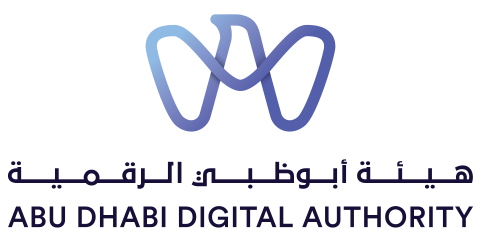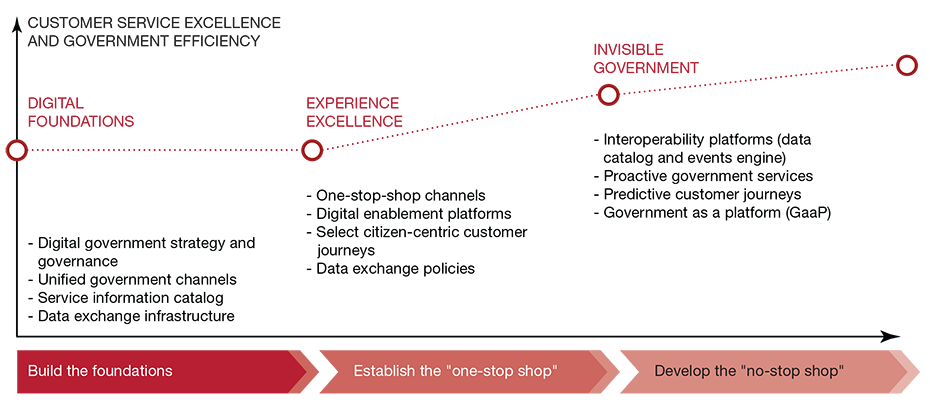{{item.title}}
{{item.text}}

{{item.title}}
{{item.text}}
The proliferation of digital applications has revolutionized customer service. Customers need personalized service with minimal interactions. That need puts service providers, both public and private, under pressure to change their business models through digital transformation. Such changes offer major opportunities and challenges for government entities in Gulf Cooperation Council (GCC) countries. What these entities must aim for is the ambitious goal of “invisible government,” proactively providing services in a seamless manner that allows government to act as an enabler. Such invisible government customer service will make constituents’ lives easier and allow these entities to operate more efficiently. This is a vital step as governments must now compete with each other to attract constituents and businesses as the world becomes more global and interconnected.
To achieve this transformation, government entities need strategies to intensify their efforts to digitize services. In particular, they must progress beyond the “one-stop-shop” service delivery concept. Instead, they need invisible government so that customers do not have to request a service. Rather, they benefit automatically from the services for which they are eligible, without additional interaction. For example, private companies would receive clearances and approvals while performing their daily business without filing a request. To provide such a service, government entities should build their knowledge of their customers through facilitating data exchange among themselves.
Successful transformation also requires the government to change how it develops services. It must enhance the digital platforms that enable service delivery, gradually, cumulatively, and in coordination with all government entities. In particular, all government entities must adopt new practices across the value chain of service delivery from planning to implementation. They must rapidly conceptualize and develop new, integrated services for customers. On the technology front, they must introduce platforms that allow digital services to be expanded efficiently.
Governments throughout the world are competing to encourage businesses to open in their countries. The ease and convenience of interaction with the relevant government is one of the crucial factors for companies in deciding where to be located. If governments wish to succeed in this contest, they should adopt the invisible government approach to providing services.
Take, for example, the GCC region where interaction with the government can be timeconsuming and frustrating, deterring many companies from setting up operations. In response, government entities in the region have made great efforts in recent years to modernize and digitize their services. For example, the government of Abu Dhabi has established a one-stopshop for all government services. It is referred to as “TAMM” and is the home of Abu Dhabi Government Services across its digital, contact, and services centers. TAMM is built on an entire ecosystem of digital capabilities and offers a growing portfolio of more than 500 digital services.
Around 98 percent of total government transactions in Abu Dhabi are now carried out through digital channels, such as mobile apps or online. The vast majority of government service fees, some 85 percent in some jurisdictions, are also collected electronically, such as through online payment. These developments will have a positive impact for all businesses, citizens, residents, and even visitors to Abu Dhabi.
However, customers are still looking for more personalization and for governments to be more proactive. This desire from constituents should push governments to be ambitious and do more. According to a recent survey in one GCC country, around 30 percent of customers are “dissatisfied” with the complexity of the information on official websites and the amount they were required to provide. Customers seek services that are intuitive and convenient. Investors want clarity on the registration process and requirements and on investment opportunities, while drivers are looking for online training and speedier license processing and delivery.
To improve the customer experience, governments have been building unified service delivery platforms. In this more centralized model, the list of services and offerings are simplified, thus contributing to enhanced customer experience.
However, governments need to move away from legacy bureaucracy to deal with service requests. Instead, the new vision of invisible government involves integration between various services to limit unnecessary duplication of application processes for the customer or business. It also calls for a digital engine that automatically assesses customers’ eligibility for services, together with predictive analytics to analyze customer consumption of services and suggest potential services. The predictive analytics would be based on efficient data monitoring, control, and sharing within the unified government platform. Rather than the constituent requesting a service from a government entity, the government entity would provide the service to the constituent proactively.
Such a system of invisible government creates significant benefits. Customers would enjoy an improved experience as they would benefit from government services without submitting any information. They might not even notice that a necessary government service was triggered in the background to complete a private sector service. The need for fewer manual eligibility checks reduces the administrative burden on the government. All the while, the government would accumulate data about its customers to enable automatic processes and proactive suggestions. The TAMM platform has already captured a significant amount of customer data, and is steadily deepening this secure reservoir of information, enabling the analytics and insights unit to derive meaningful conclusions. The end result is a more responsive and caring government that provides customers with a seamless experience, while fostering a business-friendly environment.
“Customers would enjoy an improved experience as they would benefit from government services without submitting any information. They might not even notice that a necessary government service was triggered in the background to complete a private sector service.”
The process toward invisible government begins by laying the foundations, which include creating a nationwide digital government strategy and infrastructure for data exchange. Document digitization should be expedited, and selected customer-centric journeys should be launched on the unified government digital channels to create momentum.
After building the foundations, governments should incorporate the most-used government services into the new system in order to bolster the unified channels. Services need to be bundled around customer journeys or life events. Designing services around life events has proved to be the most effective way of reducing customer touchpoints in government services.
Introducing invisible government involves mature data interoperability, which follows the once only principle and uses data analytics to offer proactive government services and predictive and dynamic journeys. Ultimately, governments would be able to open the platform to private sector companies and government entities to develop their own integrated services by using government services through an open API cloud platform.
The invisible government is an ambitious, attainable, and necessary. Governments should transform their services toward invisible government by taking advantage of advances in digital technology. They must strengthen their digital service platforms in a coordinated, incremental manner; start new practices across the value chain of service delivery from planning to implementation; and quickly conceptualize and develop new, integrated services. They must also introduce platforms that lead to the cost-efficient scaling up of digital services. By taking these steps, governments can provide quality services in a manner that enables their customers and attracts international business and investment to their country.
The Abu Dhabi Digital Authority (ADDA) is leading the digital future of Abu Dhabi by supporting its government partners to deliver services and build ecosystems that enrich quality of life and multiply opportunities for business and personal growth. The ADDA seeks to enable, support, and deliver a digital government that is proactive, personalized, collaborative and secure. It supports Abu Dhabi’s digital transformation through strategies, policies, standards, and enterprise architecture for increased government performance. In addition, the ADDA delivers digital services, platforms and channels, and implement applied intelligence, shared government, and cybersecurity solutions for government entities. The ADDA is mandated to drive Abu Dhabi’s digital future to become a leading hub for digital transformation and innovation in the region.
His Excellency Mohamed Abdelhameed Al Askar is the Director-General of the Abu Dhabi Digital Authority. Al Askar provides direction on a diverse range of initiatives and is an experienced leader in the digital field with a demonstrated history of working in the government administration industry. He has managed several programs and projects such as the Abu Dhabi Government Services Program (TAMM), Abu Dhabi Information Security Program, Data Management Program, Smart Services Program, Enterprise Service Maturing Project, and the Government Procurement Program.
Her Excellency Aisha Al Marzooqi is the Executive Director of the Government Services Sector at the Abu Dhabi Digital Authority. Al Marzooqi specializes in government service modernization. She has led Abu Dhabi’s whole-of-government digitization programs since 2017 including the document digitization and data exchange (AD-Connect) programs. Al Marzooqi has particular expertise in digital transformation.



Menu